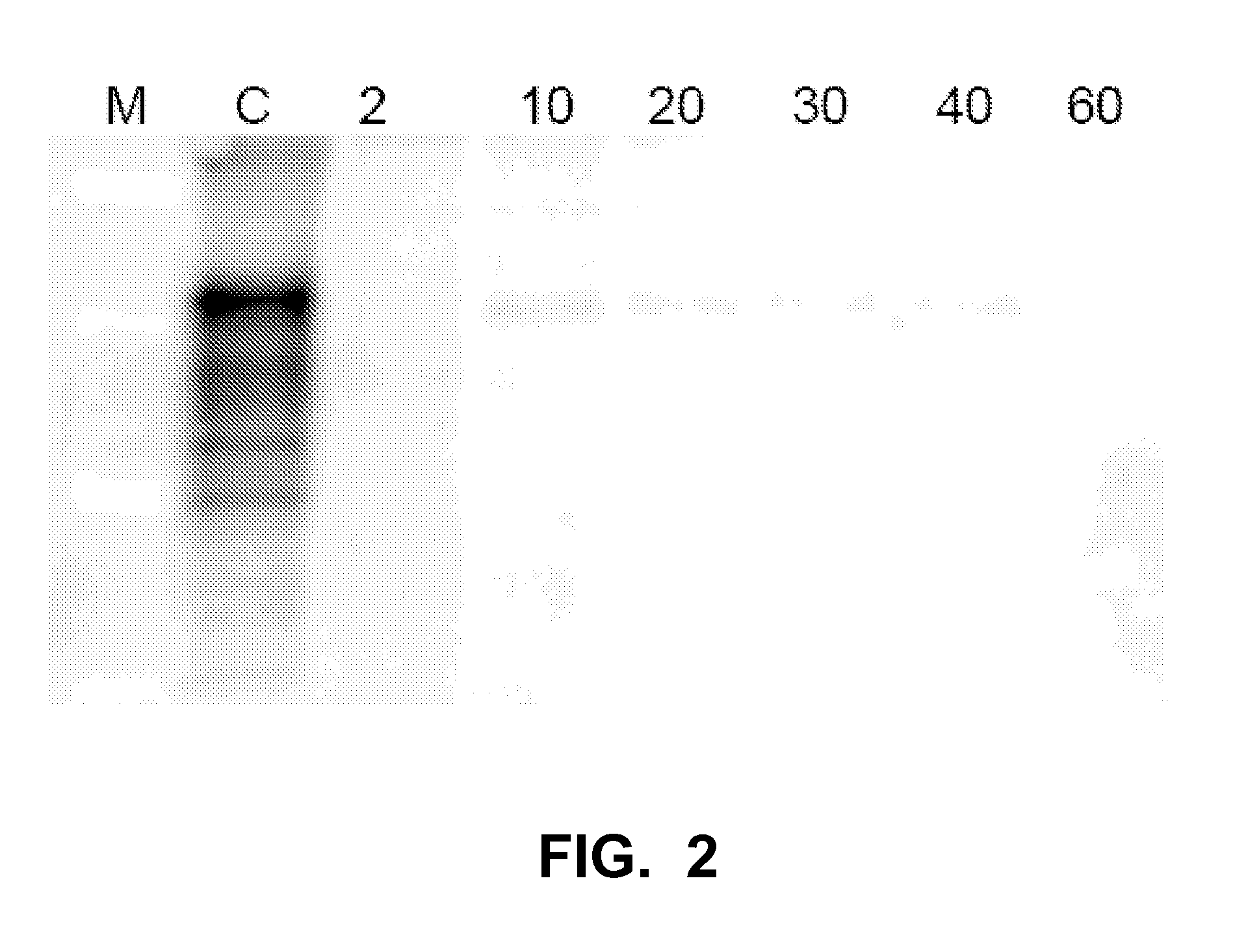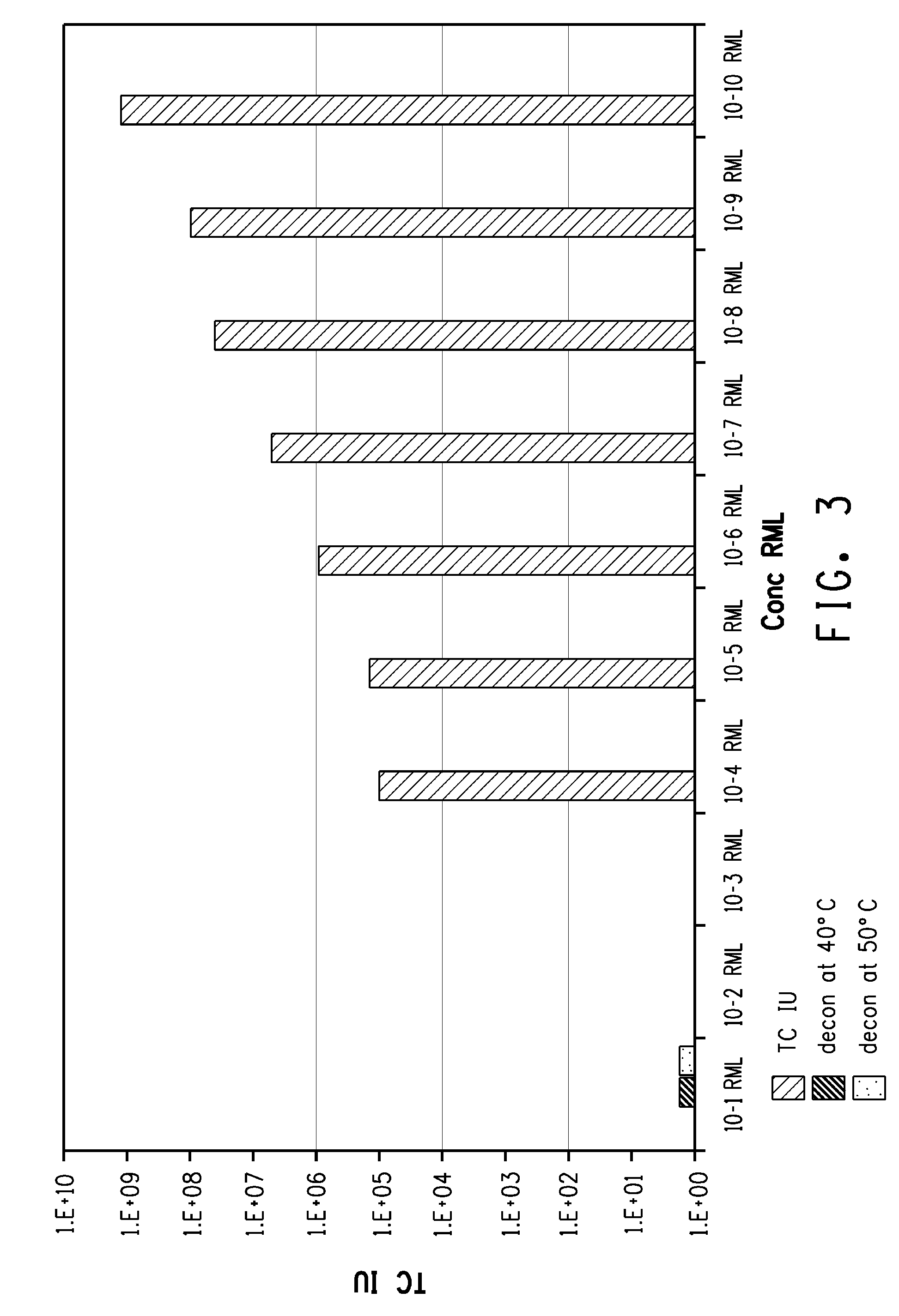Compositions and methods for prion decontamination
a technology of prion and prion, which is applied in the direction of detergent compounding agents, peptide/protein ingredients, peptide sources, etc., can solve the problems of inability to pre-surgically test patients, inability to quarantine or destroy used instruments, and need for new methods of decontamination, etc., to achieve the effect of reducing the titre of infective prions
- Summary
- Abstract
- Description
- Claims
- Application Information
AI Technical Summary
Benefits of technology
Problems solved by technology
Method used
Image
Examples
example 1
Combined Oxidation and Protease Treatment
[0148]This example describes methods by which an entity contaminated with the infectious material PrPSc can be decontaminated and the infectious material deactivated in an aqueous suspension by sequential exposure of the entity (in the example the entity is infected brain tissue) to an oxidizing agent plus SDS as surfactant and two proteolytic enzymes (ALCALASE® and NEUTRASE®).
Preparation of Tissue Samples:
[0149]Brain of CJD-infected human frontal cortex was homogenized to 20% (w / v) in PBS Dulbecco GIBCO-BRL 14190-094 (Paisley, UK), phosphate buffer solution, referred to hereinafter as “PBS”, by passing the brain tissue through 18-gauge, 21-gauge and 23-gauge needles to produce “homogenate”. The homogenate was diluted to 15% w / v with PBS, frozen in small aliquots and stored at −70° C.
Protocol A: Use of ALCALASE® / NEUTRASE® Concentrations in the Presence of PERASAFE™ Sterilant
[0150]Each reaction was performed at a total volume of 100 μL, contai...
example 2
Prion Decontamination Comparison Using PERASAFE™ Sterilant Treatment Only and PERASAFE™ Sterilant and Protease Treatment in a Single Step
[0158]In this Example, prion decontamination is demonstrated according to the present invention by oxidation using PERASAFE™ Sterilant and protease treatment (Protocol C), compared with ineffective prior art treatment of PERASAFE™ Sterilant only (Protocol B).
Protocol B: PERASAFE™ Sterilant Only Treatment (Comparative)
[0159]The following protocol was used to prepare samples treated only with PERASAFE™ Sterilant.
[0160](a) A 5× PERASAFE™ Sterilant stock solution was prepared, 1 mL, by adding 81 mg of PERASAFE™ Sterilant powder to 1 mL of distilled and deionized (dd) H2O at 37° C. Vortex mixing was used to dissolve the powder and the solution was incubated at 37° C. for 15 minutes.
[0161](b) 300 μL of CJD 10% w / v brain homogenate was prepared and subjected to vortex mixing to ensure even suspension by spinning in a microfuge at minimum speed setting of ...
example 3
Decontamination of Surgical Surfaces
[0191]The prion-degrading materials (oxidizing agent and proteases) produced by Protocol B of Example 2 were carried out on infected homogenate dipped steel wire segments.
[0192]Steel wires (5 mm×0.15 mm) were incubated for 30 minutes with a 20% homogenate prepared from the brain of a CD1 mouse terminally sick with Rocky Mountain Laboratories (RML) scrapie.
[0193]The wires were then treated according to the present invention and significant decontamination was observed for treatment under Protocol B.
[0194]A comparison was performed using Protocol B—use of oxidizing agent alone (PERASAFE™ Sterilant) was not effective.
PUM
| Property | Measurement | Unit |
|---|---|---|
| temperature | aaaaa | aaaaa |
| concentrations | aaaaa | aaaaa |
| concentrations | aaaaa | aaaaa |
Abstract
Description
Claims
Application Information
 Login to View More
Login to View More - R&D
- Intellectual Property
- Life Sciences
- Materials
- Tech Scout
- Unparalleled Data Quality
- Higher Quality Content
- 60% Fewer Hallucinations
Browse by: Latest US Patents, China's latest patents, Technical Efficacy Thesaurus, Application Domain, Technology Topic, Popular Technical Reports.
© 2025 PatSnap. All rights reserved.Legal|Privacy policy|Modern Slavery Act Transparency Statement|Sitemap|About US| Contact US: help@patsnap.com



